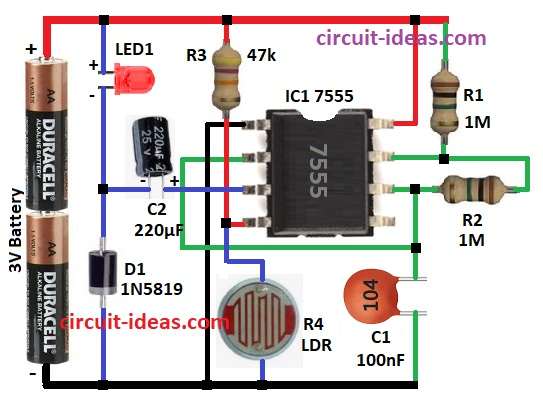Automatic Night Lamp Circuit using Battery Power works on battery and saves energy.
It turns ON in dark and OFF in light.
This circuit is good for bedroom, hallway, stairs and gives light at night.
It uses two 1.5V batteries and has 7555 timer chip, LDR as light sensor and LED as light.
Circuit Working:

Parts List:
| Component | Quantity |
|---|---|
| Resistors | |
| 1M 1/4 watt | 2 |
| 47k 1/4 watt | 1 |
| LDR | 1 |
| Capacitors | |
| Electrolytic 220µF 25V | 1 |
| Ceramic 100nF | 1 |
| Semiconductors | |
| CMOS Timer IC 7555 | 1 |
| LED 5mm 20mA | 1 |
| Schottky Diode 1N5819 | 1 |
| Battery 3V | 1 |
This diagram shows how LED night lamp turns OFF in light.
Main part is LDR R4 which changes resistance with light.
At daytime LDR resistance is low and circuit stays OFF.
At nighttime the LDR resistance is high and 7555 timer turns ON and LED lights up.
7555 works like switch, resistors R1, R2 and LDR R4 make voltage divider.
If voltage at pin 2 (trigger pin) goes below 1/3 of supply then pin 3 goes HIGH and LED is ON.
Capacitor C1 100nF helps timer work well.
Capacitor C2 220µF filters the circuit to run smooth.
Diode 1N5819 stops reverse current and circuit stays safe at 3V.
Formulas with Calculations:
Formulas and Calculations for Battery Night Lamp:
LDR Resistance:
LDR changes with light.
In bright its 1k
In dark its 1M
Voltage at Pin 2 (Trigger):
Use voltage divider:
V_trigger = Vcc × R4 / (R1 + R4)
For LED to turn ON then V_trigger < 1V
Use formula:
T = 1.1 × R × C
R = 47k R3 and C = 220µF C2
T = 1.1 × 47000 × 0.00022 = 11.374 sec
How to Build:
To build a Automatic Night Lamp Circuit using Battery Power following the below mentioned steps:
- Collect all parts from circuit diagram.
- Pin 1 of IC1 7555 goes GND.
- Pin 2 connect to pin 6 of IC1.
- Pin 3 connect to + of C2.
- Negative of C2 connects between cathode of LED1 and D1 anode.
- Pin 4 connect to positive supply through R3.
- R2 connects between pin 6 and pin 7.
- R1 goes between pin 7 and positive supply.
- LDR R4 connects from pin 4 to GND.
- C1 goes from pin 2 to GND.
- Pin 8 connect to +3V battery.
- Connect battery positive to positive supply and negative to GND.
Conclusion:
Automatic Night Lamp Circuit using Battery Power is an easy and low power project.
It turns ON at dark and OFF at light and saves energy.
IC 7555 helps it work smooth and uses less power.
We can change LDR or resistor to adjust light sensitivity.
Leave a Reply